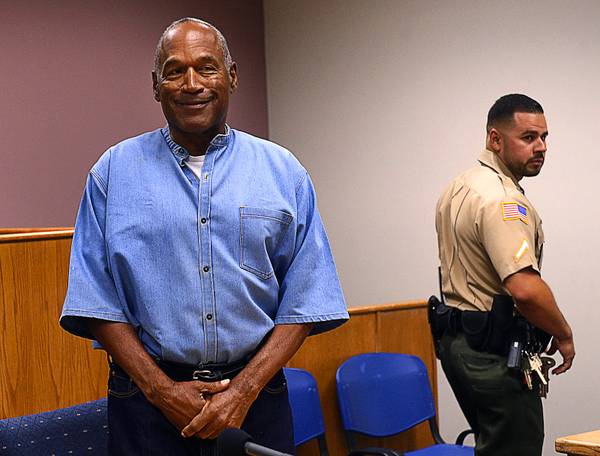Related content
Last month, before voting to release O.J. Simpson from prison after nine years, the Nevada parole board discussed in detail the robbery that put him behind bars and his conduct as an inmate. But one piece of Simpson’s record escaped the notice of the board, the news media and most of the millions of people watching on television and online.
During the hearing July 20, members of the Nevada Board of Parole Commissioners said that before his 2008 conviction for the robbery in a hotel in Las Vegas, Simpson had no history of a criminal conviction. That was incorrect.
As the world knows, Simpson was acquitted in 1995 of the killings of his former wife Nicole Brown Simpson and Ronald Goldman, in the most-watched trial in U.S. history. But in 1989, he pleaded no contest in Los Angeles to misdemeanor battery of Nicole Brown Simpson, who was then his wife.
The Nevada parole board did not have that information, officials with that agency said this week, so the 1989 conviction was not considered when a four-member panel voted unanimously to release him in October.
When states weigh the risk posed by an inmate, they routinely look through their own records and also check with the National Crime Information Center, a set of enormous databases of records run by the FBI. Simpson’s 1989 conviction “did not appear in the NCIC history” when Nevada officials prepared a pre-sentencing report after his 2008 conviction, said David M. Smith, hearings examiner for the parole board.
He said the parole commissioners relied in part on the information in that 2008 report in assessing whether Simpson should be released. Smith’s response came in a written statement in response to questions from The New York Times, which began inquiring about Simpson’s record after a reader noted the 1989 case.
To see if it had made an error, the parole board checked the NCIC again after the inquiry by The Times.
“This most recent report also makes no mention of the 1989 California court record,” Smith said.
The parole commissioners declined to be interviewed. Smith said it was impossible to tell whether knowing of the misdemeanor conviction would have influenced their decision on Simpson, 70, who has had no disciplinary record from his time in prison. The decision is not subject to review unless Simpson violates the terms of his release.
Although a jury in Los Angeles found Simpson not guilty of killing Goldman and Nicole Brown Simpson, a civil jury later found him responsible for their deaths. The killings have cast an inescapable shadow over every aspect of his life since then. Because he was acquitted of the killings, the Nevada parole board legally could not take that case into account in making its decision.
It is not clear why the 1989 case failed to turn up in the federal system, and California court officials said they did not have an explanation. But the omission highlights a frequent problem: There are major gaps in the databases, which rely primarily on accurate and complete reporting by local and state agencies.
In 2007, Simpson and a group of other men, two of them carrying guns, went to the Las Vegas hotel room of a sports memorabilia dealer and took hundreds of items from him. Simpson said he was merely reclaiming property that had been stolen from him, but he was convicted in 2008 of robbery, kidnapping and other charges.
A judge sentenced him to nine to 33 years in prison, but did not take the 1989 conviction into account because it was not in the pre-sentencing report. Simpson became eligible for parole for the first time this year.
At his parole hearing, Simpson said, “I basically have spent a conflict-free life” and “I’ve always been a guy that got along with everybody,” although Nicole Brown Simpson and others had said he beat her multiple times.
The 1989 case was reported by news media at the time and received a fresh round of attention after Simpson became a suspect in the killings.
In the 1989 case, prosecutors charged that early on New Year’s Day, at the Simpson home in the Brentwood section of Los Angeles, Simpson punched, kicked and slapped his wife while yelling “I’ll kill you.” He first denied the accusations, but a few months later, he pleaded no contest to one count of spousal battery.
The charge carried a maximum sentence of a year in jail, but a judge opted not to incarcerate Simpson, instead ordering him to perform community service and receive counseling.

